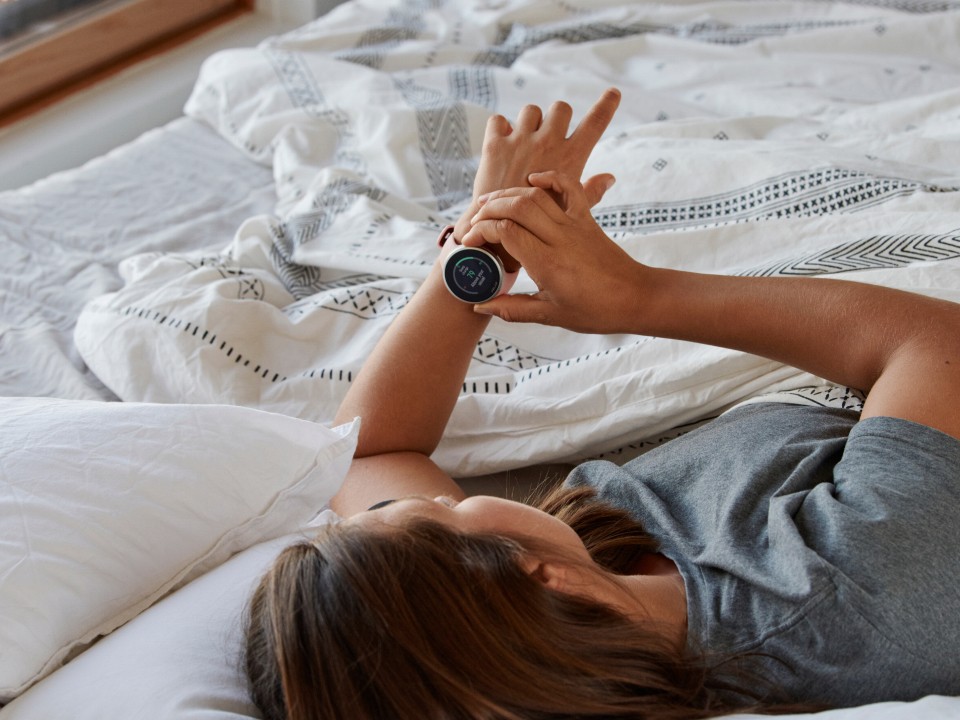What if every morning when you wake up, your body could tell how it actually feels? No positive spin on things but a simple, clear insight into your general wellbeing. Well, say hello to your heart rate variability.
We like to think our heartbeat is consistent, like clockwork, keeping the same precise beat at all times. As it turns out, the only thing consistent about your heart is how it changes. Whether relaxing with a good book or sprinting up a hill, your heart rate constantly fluctuates throughout each day. And so is the time between each heartbeat.
Heart rate variability is the whisper that has a lot to say. Such minor variations tell us a lot about critical factors like your physical fitness, stress, and sleep. So, it is one insight you should take notice of each morning.
In this blog, we’ll explore what heart rate variability is, its relationship with your autonomic nervous system, the causes of low and high HRV scores and how to improve them, and how to track your HRV with Polar Nightly Recharge™, and how to use an HRV monitor to perform an Orthostatic Test.
What is heart rate variability?
You often hear the term HRV these days in relation to sleep, training, and stress – but what exactly does it mean?
A healthy heart isn’t a metronome that keeps a regular rhythm: the time between each beat varies. While heart rate refers to the number of times your heart beats per minute. Heart rate variability (HRV) measures the fluctuation in the time intervals between adjacent heartbeats. This beat-to-beat interval variation is measured in milliseconds and can vary depending on a number of factors.
For instance, the interval between heartbeats is generally longer on your exhales and shorter when you inhale. So even if your heart rate is 60 beats per minute, the time between these beats is rarely one exact second. Within the same minute, you could have a 0.8-second interval between one set of heartbeats and then a 1.13-second interval between another set.
So, why measure it at all? As it turns out, this tiny fraction of a second is anything but insignificant. It can tell you quite a lot about your body, providing insights that are instrumental to understanding your health and wellbeing, from how well you recover at night to the presence of heart conditions or anxiety.
There are a variety of factors that can influence or change your HRV metrics. These include:
- Respiration
- Exercise volume and intensity
- Rest and recovery from workouts
- Hormones
- Metabolism
- Chronic health conditions
- Stress
- Sleep habits and quality of sleep
- Diet
- Age and gender
- Genetics
Another reason for this great variance in heart rate is our nervous system. Your parasympathetic nervous system receives input from your organs, which can cause a decrease in your heart rate. On the other hand, your sympathetic nervous system reacts to outside factors like exercise and stress and can increase your heart rate.
These simultaneous signals that two branches of our nervous system send to our heart cause it to constantly fluctuate, directly influencing your heart rate variability numbers.
Let’s explain this relation a little bit more.
Heart rate variability and the autonomic nervous system
Your heart rate constantly changes throughout the day – from the stressful surge as you run to catch a bus to the subtle variations of HRV. Yet, your heart doesn’t figure these changes out independently but relies on your autonomic nervous system (ANS) for guidance.
This branch of your nervous system handles everything involuntary that occurs without you even being aware of it. From body temperature changes to digestion, your ANS is constantly working in the background, monitoring your internal functions while also interpreting signs of what is happening around you at a moment’s notice.
Your ANS is made up of multiple divisions, including your:
- Sympathetic nervous system (SNS or ‘fight or flight’ response)
- Parasympathetic nervous system (PSNS or ‘rest and digest’ response)
Throughout the day, your ANS will work to keep these two divisions in balance as you go about your life. Your SNS will be activated when something stressful or exciting happens, and your PSNS will be activated when it’s time to calm down and relax.
Measuring your heart rate variability is a simple way to track this ANS balance because both your SNS and PSNS directly affect your heart’s activity. Low HRV signals that your fight or flight response is activated, while high HRV signals that your rest and digest response is functioning effectively. Essentially, the more relaxed you are, the higher the variation between heartbeats.
What is good heart rate variability?
You’re probably wondering what is normal when it comes to heart rate variability. It’s important to understand that this metric is particular to you and isn’t something that you can target or compare with others. So, the only person worth measuring against is yourself and how your HRV has been in recent weeks.
Of course, physical factors, often beyond our control, influence your heart rate variability too. In general, younger people tend to have higher HRV numbers than older people, males will often have higher numbers than females, and elite athletes will have higher numbers than just about everyone else. Your HRV will decrease as you age, and it’s normal for you to experience seasonal (or even daily) fluctuations. What is normal for you this month may differ from next month and next year.
What HRV does show you is how adaptable your body can be. A highly variable heart rate indicates your body is fit and healthy enough to handle change. At the same time, there will be situations where having low HRV is positive, such as during strenuous exercise. During these workouts, your body will use your SNS to increase your heart rate, but your PSNS should kick in later to help you recover.
As you will see below, the best time to measure your HRV is while you’re asleep. So, sometimes your HRV score will be influenced by factors that affect your sleep and other physiological signs.
High HRV is usually a sign that:
- You have good cardiovascular fitness.
- You are resting and recovering well.
- You are currently more resilient to stress.
Low HRV is usually a sign that:
- You had alcohol, a late meal, or exercised a few hours before bed.
- You are dehydrated, or your bedroom is too warm.
- Your body is experiencing stress, either from outside pressure or a high-intensity workout, and is struggling to handle it.
- You may have an underlying health condition like diabetes, high blood pressure, heart arrhythmia, or asthma.
- You may be experiencing anxiety or depression.
How to improve heart rate variability
If you want to learn how to increase your HRV, think about your overall wellbeing – both physical and mental health. As we have seen, how your nervous system reacts to your thoughts, feelings, and general emotional state has as much impact on your heart rate variability as your sleep, fitness, and everyday environment.
Taking care of your mental wellbeing can improve your HRV, especially when it comes to managing stress. Understanding what causes stress in your life and learning to manage it with tools and techniques, including wearable technology, can enormously impact how good you feel and, in turn, your HRV.
Caring for your heart is another critical way to improve your heart rate variability. A nutritional diet and regular exercise will boost your physical wellbeing and enhance your cardiovascular fitness and, in turn, your HRV.
TIPS TO IMPROVE HEART RATE VARIABILITY
Improving your cardiovascular health, endurance, and heart rate variability all go hand in hand. For those looking to improve this metric for health or performance reasons, here are some basic tips you can use to improve your heart rate variability metrics.
Schedule recovery days
Training hard on too many consecutive days without a day of rest or recovery can leave your body feeling run down. For this reason, schedule active recovery workouts or recovery days following a hard block of training.
Make hydration a priority
Being hydrated can improve circulation and make it easier for your blood to deliver oxygen to the body. This can have a direct impact on your training, health, and overall stress.
Get serious about nutrition
Did you know that alcohol can affect your heart rate variability for as long as five days? Poor nutrition can also have a similar effect on your data and impact how your body feels while working out.
Be consistent
Your body will adapt to your training load more easily when you’re consistent. This can involve things like working out at the same time of day, having a set sleep schedule, and avoid those random binge nights with junk food on the weekends.

Heart rate variability and NIGHTLY RECHARGE™
The best time to test your HRV daily is actually at night. That’s the best period to automatically measure and interpret heart rate, breathing rate, and other metrics in real life settings. While asleep, your body is rarely disturbed by outside influences in your environment, making it the perfect time to consistently track your heart rate variability, too.
Polar Nightly Recharge™ provides insights into your HRV and more each morning with your ANS Charge metric. Measuring how well your autonomic nervous system calmed down during the first hours of sleep and comparing it to your previous 28 days can help you understand if your HRV is higher or lower than recently. The ANS Charge metric also provides information on your average heart rate and breathing rate during the night.
So, you can wake up each morning and know what your heart rate variability is and then reflect if factors like stress, alcohol, or environmental changes might affect your score.
Heart rate variability: A Tiny Change Can Tell a Lot
Remember, your heart rate variability is a highly personal metric and cannot be compared to anyone else, so it’s essential to track it for your unique insights regularly.
Here is an overview of key points from this blog:
- Heart rate variability is the constant variation between your heartbeats.
- You can only measure it with specialized devices.
- HRV provides a surprising number of insights into your health and wellbeing.
- It is guided by your autonomic nervous system and how well it balances your sympathetic nervous system and parasympathetic nervous system.
- The more relaxed you are, the higher your HRV will be.
- It will also decrease as you age and go through seasonal fluctuations.
- Improving your physical and mental health will improve your HRV score.
- Polar Nightly Recharge™ provides quick insight into your health with your HRV each morning.
If you liked this post, don’t forget to share so that others can find it, too.
Or give it a thumbs up!
I like this article
Please note that the information provided in the Polar Blog articles cannot replace individual advice from health professionals. Please consult your physician before starting a new fitness program.

